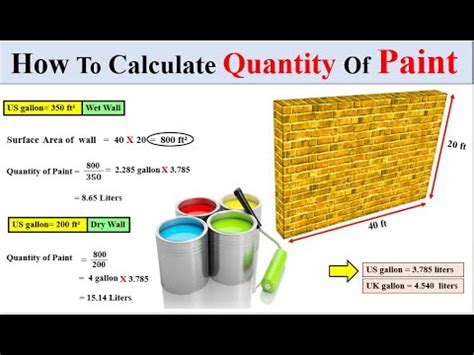Unlock a Stunning Paint Job: Accurate Gallon Calculation
A fresh coat of paint can dramatically transform your home's exterior or interior, boosting curb appeal and adding value. But before you dive into the vibrant colors and satisfying strokes, there's a crucial step that often gets overlooked: accurately calculating how much paint you need. Underestimating can lead to frustrating mid-project trips to the hardware store, while overestimating results in wasted money and extra paint disposal. This comprehensive guide will help you unlock a stunning paint job by mastering the art of accurate gallon calculation.
Understanding Paint Coverage
Before we delve into the calculations, it's essential to understand that paint coverage isn't a one-size-fits-all number. The amount of paint needed per square foot varies based on several factors:
- Type of Paint: Exterior paints, designed to withstand the elements, often have slightly lower coverage than interior paints. Similarly, primers generally require more paint per square foot than topcoats.
- Surface Texture: Smooth surfaces like drywall require less paint than textured surfaces like stucco or brick. The more textured the surface, the more paint it will absorb.
- Number of Coats: Most projects require at least two coats for optimal color and coverage. Darker colors sometimes need three coats to achieve true saturation.
- Paint Quality: Higher-quality paints often have better coverage and may require less paint overall.
Manufacturers usually provide a square footage coverage estimate per gallon on the paint can label. Remember, this is just an estimate. Always round up to account for variations.
How to Calculate the Square Footage of Your Walls
Accurately measuring your walls is the foundation of precise paint calculation. Here's a step-by-step approach:
- Measure the Height and Width of Each Wall: Use a measuring tape to determine the height and width of each wall in feet.
- Calculate the Area of Each Wall: Multiply the height by the width of each wall to find its area in square feet (height x width = area).
- Add the Areas Together: Sum the areas of all the walls to get the total square footage.
- Subtract for Windows and Doors: Measure the area of windows and doors and subtract these areas from the total wall area. Don't forget to account for trim around windows and doors.
Pro Tip: Use graph paper to sketch the room’s layout and label measurements. This visual aid can prevent errors and ensure you account for all surfaces.
How Many Gallons of Paint Do I Need?
Once you have the total paintable square footage, you can estimate the number of gallons needed. Here's the formula:
Total Square Footage / Square Footage per Gallon (from paint can) = Number of Gallons
For example: If your total paintable square footage is 400 square feet and the paint can indicates 350 square feet of coverage per gallon, you'll need approximately 1.14 gallons. Always round up to the nearest whole gallon (or half gallon) to ensure sufficient coverage, especially for two coats.
Calculating Paint for Ceilings
Ceilings require similar calculations. Measure the length and width of the ceiling, multiply them together to get the square footage, and then divide by the paint's square footage coverage per gallon. Again, remember to round up.
How do I account for multiple coats of paint?
Multiply your total gallon calculation by the number of coats you plan to apply. If you need 1.5 gallons for one coat, and you're doing two coats, you'll need 3 gallons.
What if I'm painting trim or doors?
Trim and doors require separate calculations. Measure the surface area of each and calculate the paint needed independently, using the same method as walls and ceilings. Consider using a paint specifically designed for trim for a more professional-looking finish.
How much extra paint should I buy?
It's always wise to purchase a little extra paint, about 10-20%, to account for unforeseen circumstances, touch-ups, or mistakes.
Can I use a paint calculator app?
Yes! Numerous free apps and online calculators are available to assist with paint calculations. These can simplify the process and reduce the likelihood of errors. However, always double-check the results with your own calculations to ensure accuracy.
By carefully following these steps and considering the factors affecting paint coverage, you'll significantly increase your chances of achieving a flawless, stunning paint job. Remember that accurate measurement and planning are your best allies in this project. A little extra preparation upfront will save you time and money in the long run.

